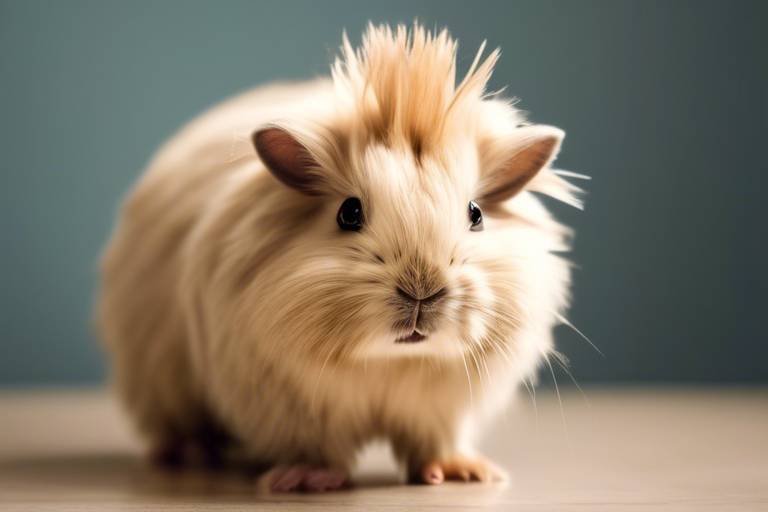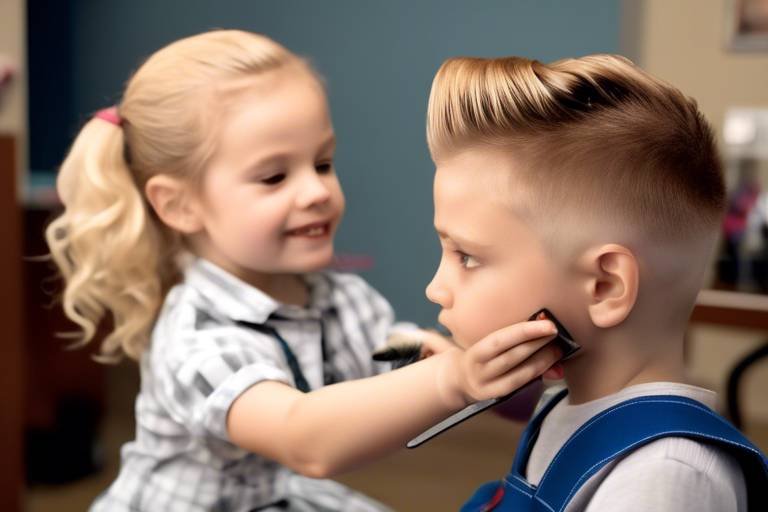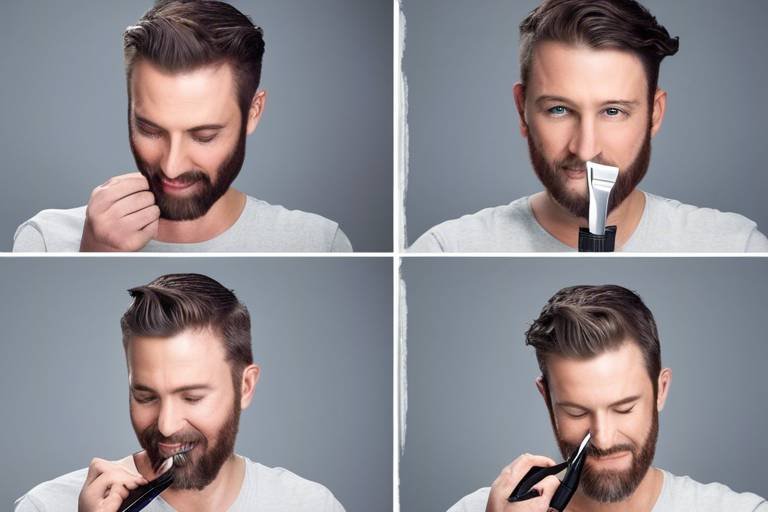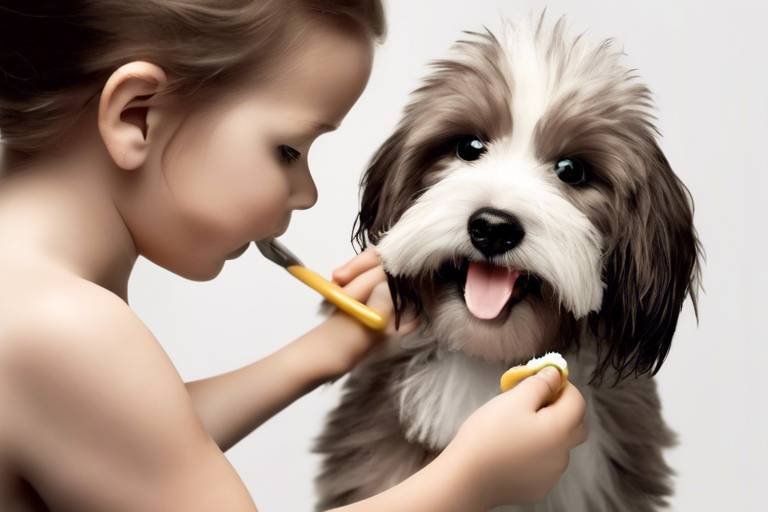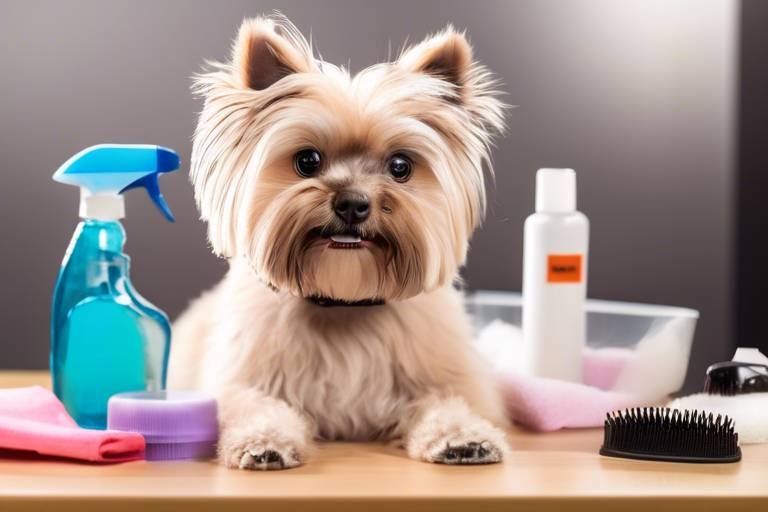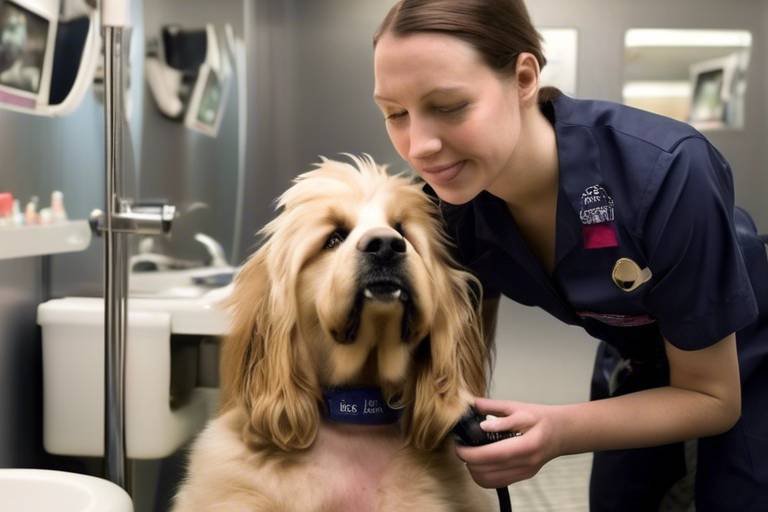The Benefits of Grooming for Small Animal Health
Grooming is more than just a routine task; it's a vital aspect of caring for small animals that can significantly enhance their quality of life. Imagine your furry friend, whether it’s a rabbit, guinea pig, or hamster, feeling fresh and clean, with a shiny coat that reflects their health and happiness. Regular grooming not only keeps their fur looking fabulous but also plays a crucial role in their overall well-being. When we talk about grooming, we’re diving into a world of benefits that touch on both physical and mental health, hygiene, and the deep bond between pets and their owners. It’s like a spa day for your pet, where they feel pampered and loved, and you get the added bonus of ensuring they stay healthy and vibrant.
So, why is grooming so essential? Well, think of it as a preventative measure. Just as we humans go for regular check-ups and maintain our hygiene, our pets need the same level of care. Grooming sessions can help in spotting any unusual lumps or skin irritations early on, allowing for timely veterinary intervention. Furthermore, it’s a fantastic opportunity to check for signs of parasites like fleas or ticks, which can cause discomfort and health issues if left unchecked.
Now, let's break down the myriad advantages of grooming into digestible parts. First off, there’s the aspect of hygiene. Regular grooming helps to keep your pet’s coat clean and free from dirt, debris, and loose fur. This is especially important for small animals, as their dense fur can trap allergens and bacteria, leading to skin irritations or infections. By brushing your pet frequently, you’re not just making them look good; you’re actively participating in their health maintenance.
Moreover, grooming fosters a sense of security and comfort in your pets. Just like a warm hug can make you feel safe, a gentle grooming session can provide your small animal with the same feeling. It’s a bonding experience that reassures them and strengthens the trust between you. When pets know that grooming is a regular part of their routine, they tend to be more relaxed and cooperative, making the process smoother for both parties involved.
In essence, grooming is a multi-faceted approach to pet care that enhances the physical and emotional health of small animals. By investing time in grooming, you’re not merely maintaining their appearance; you’re nurturing their entire being. It’s a win-win situation that leads to happier, healthier pets and a stronger bond between you and your furry companions.
- How often should I groom my small animal? It depends on the type of animal and its coat type. Long-haired breeds may need daily grooming, while short-haired ones might only require it weekly.
- What tools do I need for grooming? Basic grooming tools include a brush, comb, nail clippers, and sometimes a special shampoo for baths.
- Can grooming help with my pet's anxiety? Yes! Regular grooming can create a calming routine and help alleviate anxiety in pets, making them feel secure.
- What if my pet doesn’t like grooming? Start slowly and make it a positive experience with treats and praise. Gradually increase the grooming time as they become more comfortable.
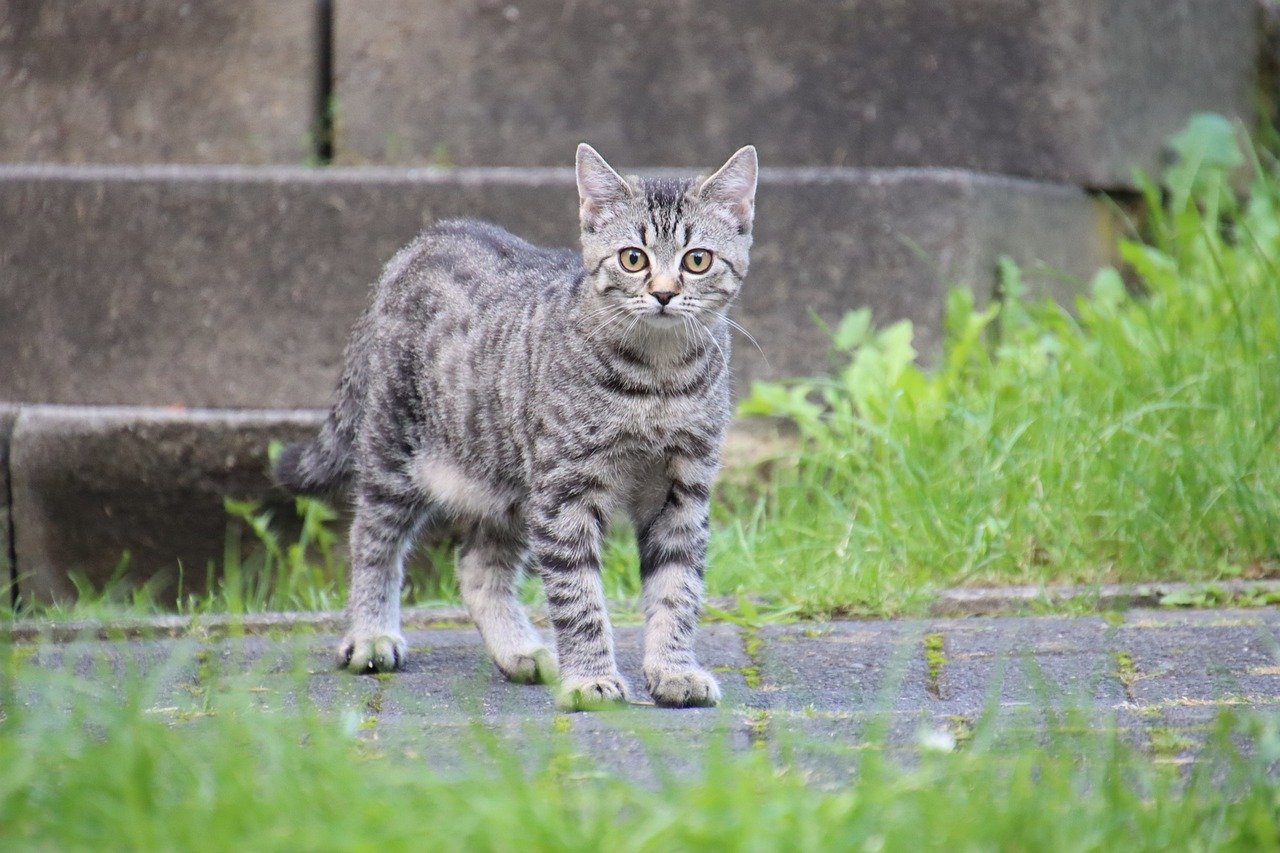
Importance of Regular Grooming
Regular grooming is crucial for maintaining the health of small animals, and it's not just about making them look good. Think of grooming as a preventive health measure—like a regular check-up at the doctor’s office. It’s an opportunity to check for any abnormalities or health issues that might be lurking beneath that fluffy exterior. By dedicating time to groom your pet, you're not only enhancing their appearance but also contributing to their overall well-being.
One of the key benefits of grooming is that it helps prevent matting and skin issues. For many small animals, especially those with longer fur, neglecting grooming can lead to tangled hair that pulls on the skin, causing discomfort and pain. Regular brushing can help avoid this issue, keeping their coat smooth and manageable. Additionally, grooming promotes better blood circulation, which is vital for the health of your pet's skin and fur. Just like us, small animals thrive when they feel comfortable in their skin.
Moreover, grooming can significantly enhance the bond between pets and their owners. When you take the time to groom your furry friend, it becomes a shared activity that can be both relaxing and enjoyable. Picture it as a spa day for your pet—who wouldn’t want that? This shared experience can create a sense of trust and security, making your pet more comfortable during grooming sessions and other interactions.
Understanding the importance of grooming extends beyond just aesthetics. It can also improve your pet’s emotional health. Animals that are regularly groomed tend to be less anxious and more relaxed. They learn to associate grooming with positive experiences, which can lead to a more well-adjusted and happy pet. In essence, grooming is not merely a chore; it’s an essential practice that fosters a deeper connection and promotes a healthier lifestyle for your small animal.
In conclusion, regular grooming is an indispensable part of pet care that offers numerous benefits. From maintaining physical health to enhancing emotional well-being, the advantages are compelling. So, the next time you pick up that brush or comb, remember that you’re doing much more than just making your pet look good; you’re actively contributing to their happiness and health.
- How often should I groom my small animal? It depends on the type of animal and their coat type. Generally, long-haired breeds may require grooming several times a week, while short-haired breeds might only need grooming once a week.
- What tools do I need for grooming? Basic grooming tools include a brush, comb, nail clippers, and possibly a grooming mitt. Make sure to choose tools that are appropriate for your pet's specific needs.
- Can grooming be stressful for my pet? It can be, especially if they are not used to it. Start slowly, use treats to create positive associations, and ensure the grooming environment is calm and quiet.
- What if I find a skin issue while grooming? If you notice any unusual bumps, redness, or other skin issues, it’s best to consult your veterinarian for a professional evaluation.

Physical Health Benefits
Grooming contributes significantly to the physical health of small animals, and it’s more than just a beauty routine. Think of grooming as a form of preventative healthcare that keeps your furry friend in tip-top shape. Regular grooming sessions not only enhance the appearance of your pet but also serve as an early detection system for potential health issues. For instance, while brushing your pet, you might notice unusual lumps, bumps, or skin irritations that could indicate underlying problems. Catching these issues early can make a world of difference in treatment outcomes.
Moreover, grooming is essential for maintaining a clean and healthy coat. A well-groomed coat is like a protective shield for your pet. When you brush your small animal, you’re not just removing dirt and debris; you’re also preventing matting, which can lead to skin irritations and infections. Regular brushing stimulates the natural oils in your pet’s skin, resulting in a shinier, healthier coat that can better withstand environmental factors such as cold weather or humidity. A clean coat is also less likely to harbor pests like fleas and ticks, which can pose serious health risks.
Another important aspect of grooming is its role in reducing allergens in the home. Grooming helps minimize allergens by removing loose fur and dander, which can be particularly beneficial for allergy sufferers. By keeping your living space cleaner, you’re not only improving your pet's environment but also enhancing your own quality of life. A cleaner home can lead to fewer allergy flare-ups, making it a win-win situation for both pets and their owners.
Additionally, regular grooming can help prevent various skin conditions, such as dermatitis and infections. By keeping your pet’s skin clean and free from irritants, you’re actively contributing to their overall skin health. For example, if your small animal has long fur, regular grooming can prevent the accumulation of moisture and debris that often leads to skin infections. This proactive approach to grooming can save you from costly vet visits and give you peace of mind knowing that you’re taking the best care of your beloved companion.
In summary, the physical health benefits of grooming small animals are profound. It’s not just about aesthetics; it’s about ensuring your pet lives a long, healthy, and happy life. By incorporating regular grooming into your routine, you’re investing in your pet’s health and well-being. So, the next time you brush your furry friend, remember that you’re doing much more than just making them look good—you’re keeping them healthy!
- How often should I groom my small animal?
It depends on the breed and type of fur. Generally, long-haired breeds require more frequent grooming, while short-haired breeds may only need grooming every few weeks. - What tools do I need for grooming?
Basic grooming tools include brushes, combs, nail clippers, and sometimes specialized tools for specific breeds. - Can grooming help with my pet's anxiety?
Yes! Regular grooming can create a calming routine that helps reduce anxiety and stress in pets. - What should I do if I find a lump while grooming?
If you discover a lump or any unusual skin condition, it’s best to consult your veterinarian for further evaluation.
Skin and Coat Maintenance
Maintaining a small animal's skin and coat is not just a matter of aesthetics; it's a vital aspect of their overall health. Just like how we feel more confident when our hair looks great, small animals benefit immensely from regular grooming sessions that focus on their fur and skin. A well-groomed coat does wonders—it acts as a protective barrier against environmental factors, helps regulate body temperature, and even plays a role in their emotional well-being. Imagine how you feel after a refreshing shower; your pet feels the same way after a good grooming session!
One of the primary benefits of grooming is the removal of dirt, debris, and loose fur. Regular brushing not only keeps the coat looking shiny and healthy but also stimulates the natural oils produced by the skin. These oils are essential for keeping the coat hydrated and resilient. When you brush your small animal, you're essentially giving them a mini massage that promotes blood circulation and enhances skin health. It's like a spa day for your furry friend!
Moreover, grooming helps prevent matting, which can be particularly problematic for long-haired breeds. Matting can lead to uncomfortable pulling on the skin, and in severe cases, it may even cause skin infections. By regularly brushing your pet, you can easily detangle any knots and keep their coat smooth and manageable. If you’ve ever tried to untangle a knotted necklace, you know how frustrating it can be! Regular grooming helps avoid that hassle for your pet.
Additionally, grooming serves as a fantastic opportunity to inspect your pet's skin for any unusual signs. During grooming, you can check for lumps, bumps, or irritations that may indicate underlying health issues. Early detection is key to addressing potential problems before they escalate. Think of it as a routine check-up; the more you know about your pet's condition, the better you can care for them.
Lastly, let’s not forget the emotional benefits that come from grooming. The gentle brushing and petting create a calming experience for your small animal, reducing stress and anxiety. It's a time for bonding, where your pet learns to associate grooming with love and care. So, the next time you pick up that brush, remember: you’re not just maintaining a beautiful coat; you’re nurturing a happy and healthy pet!
- How often should I groom my small animal? - It depends on the breed and coat type. Generally, long-haired breeds require more frequent grooming, while short-haired animals may need it less often.
- What tools do I need for grooming? - Basic grooming tools include brushes, combs, nail clippers, and grooming wipes. Always choose tools that are appropriate for your pet's coat type.
- Can grooming help with shedding? - Yes! Regular grooming reduces shedding by removing loose fur and dander, making your home cleaner and more comfortable.
- What if my pet doesn’t like grooming? - Introduce grooming gradually and make it a positive experience with treats and praise. Patience is key!
Reducing Allergens
Grooming your small animal is more than just a beauty routine; it's a powerful tool in the fight against allergens in your home. As pet owners, we often overlook the fact that our furry friends can contribute to the accumulation of allergens like fur and dander. Regular grooming sessions can significantly reduce these irritants, leading to a cleaner and healthier environment for everyone, especially those who suffer from allergies.
When you brush your pet, you're not only removing loose fur but also dander and other debris that can trigger allergic reactions. Think of grooming as a mini spring cleaning for your pet! By incorporating grooming into your regular routine, you can effectively minimize the amount of allergens circulating in your living space.
Here’s how grooming helps in reducing allergens:
- Fur Removal: Brushing your pet regularly helps to collect and remove loose fur before it has a chance to settle on furniture and carpets.
- Dander Control: Dander, which is made up of tiny flakes of skin, can be a significant allergen. Regular grooming helps to keep this in check.
- Clean Environment: A clean pet means a clean home. Fewer allergens lead to a more comfortable living situation for both pets and humans alike.
Additionally, the benefits of grooming extend beyond just the physical act of brushing. It can also involve bathing your small animal with appropriate pet shampoos that help to reduce allergens. A clean coat not only looks good but also feels good, and it can significantly cut down on the amount of allergens present in your home.
Moreover, for families with allergy sufferers, establishing a grooming routine can be a game-changer. It creates a controlled environment where pet hair and dander are managed effectively. By investing time in grooming, you're investing in the well-being of both your pet and your family members, creating a harmonious living space.
In summary, regular grooming is a simple yet effective way to reduce allergens in your home. It's an essential part of pet care that benefits everyone. So, grab that brush and make grooming a delightful bonding experience while keeping your living space allergy-friendly!
- How often should I groom my small animal?
It depends on the breed and coat type, but generally, regular grooming once a week is a good starting point. - Can grooming help with my pet's anxiety?
Yes! Regular grooming can provide comfort and reduce anxiety by creating a routine that your pet can rely on. - What tools do I need for grooming?
Basic grooming tools include brushes, combs, and pet-friendly shampoos. Depending on your pet's needs, you may require additional items.
Preventing Skin Conditions
When it comes to our beloved small animals, skin health is often overlooked. However, regular grooming plays a pivotal role in preventing various skin conditions that can lead to discomfort and health complications. Just like how we need to take care of our skin, our pets require the same level of attention. By incorporating grooming into their routine, we can help maintain their skin health and prevent issues such as dermatitis, infections, and irritations.
One of the most significant benefits of grooming is its ability to keep the skin clean and free from irritants. During grooming sessions, pet owners can easily spot any unusual changes in their pet's skin, such as redness, swelling, or unusual bumps. Early detection is key! By identifying these issues promptly, you can consult with a veterinarian before they escalate into more severe problems.
Moreover, regular brushing helps remove dirt, excess oil, and dead skin cells that accumulate on the coat and skin. This not only promotes a healthier environment for your pet but also stimulates the natural oils in their skin, leading to a shiny and healthy coat. Think of grooming as a spa day for your pet—it's not just about looking good; it’s about feeling good from the inside out!
Additionally, grooming can significantly reduce the risk of skin infections. When fur becomes matted or dirty, it can trap moisture and bacteria against the skin, creating a breeding ground for infections. By keeping your pet’s coat well-groomed, you can minimize these risks and ensure that their skin remains healthy and resilient.
To further emphasize the importance of grooming in preventing skin conditions, consider the following points:
- Regular Brushing: Helps remove debris and prevents matting.
- Skin Checks: Allows for early detection of potential issues.
- Moisture Control: Reduces the risk of infections by keeping the skin dry.
- Stimulates Natural Oils: Promotes a healthy, shiny coat.
In conclusion, grooming is not just a cosmetic necessity; it is a vital component of your small animal's overall health. By prioritizing regular grooming, you can prevent skin conditions and ensure that your furry friend remains happy, healthy, and comfortable.
Q: How often should I groom my small animal?
A: The frequency of grooming depends on the type of animal and their coat type. Generally, long-haired breeds may require grooming several times a week, while short-haired breeds can be groomed less frequently.
Q: What tools do I need for grooming?
A: Essential grooming tools include brushes, combs, nail clippers, and sometimes, specialized shampoos. Always choose tools that are suitable for your specific pet's coat type.
Q: Can grooming help with my pet's allergies?
A: Yes! Regular grooming helps reduce allergens in your home by removing loose fur and dander, creating a cleaner environment for both you and your pet.
Q: What should I do if I notice skin issues during grooming?
A: If you spot any unusual skin conditions, consult your veterinarian as soon as possible for a thorough examination and appropriate treatment.
Behavioral and Psychological Benefits
Grooming is often perceived as a mere necessity for maintaining the physical appearance of small animals, but it goes far beyond that. In fact, the of grooming are profound and can significantly enhance the quality of life for your furry friends. Imagine the feeling of a gentle brush gliding through your pet's fur; it’s not just a grooming session, it’s a moment of connection and trust. Regular grooming sessions can act as a form of therapy for your pets, helping to reduce anxiety and stress levels.
When small animals are groomed consistently, they begin to associate these sessions with positive experiences. This association fosters a sense of security and comfort, as they realize that grooming is a time for affection and care. Just as we humans enjoy a relaxing spa day, pets too can benefit from the calming effects of being groomed. Think of it as a mini-vacation for them, a break from the hustle and bustle of their daily lives.
Moreover, grooming can serve as a valuable bonding experience between pets and their owners. The time spent together during grooming can strengthen the relationship, building trust that can lead to a more harmonious household. When pets feel secure and loved, their overall behavior improves. They are less likely to exhibit signs of stress or anxiety, which can manifest in various ways, such as excessive barking, hiding, or destructive behavior.
To further illustrate the psychological impact of grooming, consider the following points:
- Reduction of Anxiety: Regular grooming can calm anxious pets, making them feel more secure in their environment.
- Enhanced Socialization: Groomed pets are often more sociable and less fearful, making interactions with other animals and humans more pleasant.
- Routine and Structure: Establishing a grooming routine provides a sense of predictability, which can be comforting for small animals.
In essence, grooming is not just about aesthetics; it's a holistic approach to pet care that encompasses both physical and mental well-being. By investing time in grooming, you are not only enhancing your pet's appearance but also nurturing their emotional health. This dual benefit makes grooming an essential aspect of responsible pet ownership.
Here are some common questions pet owners have regarding the grooming of small animals:
- How often should I groom my small animal? - The frequency of grooming depends on the breed and type of fur. Long-haired breeds may require daily grooming, while short-haired ones may only need it weekly.
- What tools do I need for grooming? - Basic grooming tools include brushes, combs, nail clippers, and pet-safe shampoos. Always choose tools appropriate for your pet's fur type.
- Can grooming help with my pet's shedding? - Yes! Regular grooming helps remove loose fur and reduces shedding, making your home cleaner.
- Is grooming stressful for pets? - It can be, especially if they are not used to it. Introduce grooming gradually and ensure it is a positive experience.

Bonding Through Grooming
When it comes to our beloved small animals, grooming is so much more than just a chore; it’s a special time to connect and bond. Imagine this: you’re sitting on the floor with your furry friend, brushing their coat gently while they lean into you, eyes half-closed in bliss. This intimate moment not only nurtures their physical health but also strengthens the emotional ties between you and your pet. Grooming can be a form of communication, a way to express love and care, creating a shared experience that both you and your pet cherish.
Establishing a consistent grooming routine can be remarkable for both parties. Think of it as a ritual that signals to your pet that it’s time for some quality bonding. Just like humans thrive on routine, small animals find comfort in predictability. When you create a grooming schedule, your pet begins to anticipate these moments with excitement rather than fear. This predictability fosters a sense of security, making your furry friend more comfortable during grooming sessions.
Moreover, the act of grooming can be incredibly soothing. The gentle strokes of a brush can help calm an anxious animal, reducing stress and promoting relaxation. It’s almost like a mini spa day for your pet! This relaxation can lead to a more cooperative pet, making the grooming process smoother and more enjoyable. The key here is to ensure that the experience is positive; use treats, gentle words, and lots of praise to reinforce good behavior.
As you spend time grooming, you’ll also have the chance to observe your pet closely. This is an excellent opportunity to check for any abnormalities, such as lumps or skin irritations, which can lead to early detection of health issues. Being attuned to your pet’s physical state during these sessions can significantly enhance their overall well-being.
To make the most of your grooming time, consider the following tips:
- Choose the Right Tools: Use brushes and combs that are suitable for your pet’s coat type. This ensures a more effective and comfortable grooming experience.
- Keep It Positive: Always associate grooming with good experiences. Offer treats and praise to create a positive atmosphere.
- Be Patient: Some pets may take time to adjust to grooming. Patience is key to building trust.
In essence, grooming is a beautiful way to deepen the bond with your small animal. It’s a time to connect, to show love, and to ensure their health and happiness. So, the next time you pick up that brush, remember you’re not just grooming; you’re nurturing a relationship that will last a lifetime.
Q: How often should I groom my small animal?
A: The frequency of grooming depends on the type of small animal and their coat type. Generally, long-haired breeds may require grooming several times a week, while short-haired breeds may only need it once a month.
Q: What tools do I need for grooming?
A: Essential grooming tools include brushes, combs, nail clippers, and pet-safe shampoos. The specific tools will depend on your pet's coat type and grooming needs.
Q: Can grooming help with my pet's anxiety?
A: Yes! Regular grooming can provide comfort and security for pets, reducing anxiety levels. The routine and physical touch can be very soothing for them.
Q: What should I do if my pet doesn’t like grooming?
A: Gradually acclimate your pet to grooming by starting with short sessions and using treats to create a positive association. Patience and gentleness are key!
Establishing Trust
When it comes to grooming small animals, one of the most significant benefits is the opportunity it provides for between pets and their owners. Imagine a scenario where every time you approach your furry friend with a brush or a comb, they don't flinch or run away. Instead, they come to you, tail wagging or nose twitching with excitement. This is the kind of trust that can be built through consistent and gentle grooming sessions.
Trust is not something that happens overnight; it’s a gradual process that requires patience and positive reinforcement. When you make grooming a regular part of your pet's routine, they begin to associate it with comfort and care rather than fear or discomfort. This is vital because many small animals, particularly those that have been rescued or have had negative experiences in the past, may initially be wary of grooming tools and the grooming process itself.
To foster this trust, it’s essential to follow a few simple guidelines:
- Start Slow: Begin with short grooming sessions using gentle strokes. Gradually increase the duration as your pet becomes more comfortable.
- Use Positive Reinforcement: Reward your pet with treats or praise during and after grooming sessions. This creates a positive association with grooming.
- Be Observant: Pay attention to your pet's body language. If they seem anxious or uncomfortable, take a step back and give them a break.
Over time, as your small animal learns to trust you during grooming, you’ll notice a remarkable transformation in their behavior. They will likely become more relaxed, cooperative, and even look forward to these sessions. This bond not only enhances the grooming experience but also enriches your relationship with your pet, making them feel secure and loved.
Furthermore, establishing trust through grooming can also lead to a deeper understanding of your pet's needs. Regularly handling your small animal allows you to notice any changes in their skin, coat, or overall demeanor, which can be crucial for early detection of health issues. This proactive approach can make a significant difference in maintaining their health and happiness.
In conclusion, grooming is not just a task; it’s a vital part of nurturing a loving and trusting relationship with your small animal. By prioritizing grooming and approaching it with care and consideration, you are not only enhancing their physical appearance but also building a lasting bond that will benefit both you and your furry companion.
Here are some common questions pet owners often have about grooming and establishing trust with their small animals:
- How often should I groom my small animal? It depends on the breed and coat type. Generally, regular grooming every few weeks is advisable.
- What tools do I need for grooming? Essential tools include brushes, combs, and nail clippers. The type of brush may vary based on your pet's coat.
- Can grooming help with behavioral issues? Yes, consistent grooming can help reduce anxiety and improve overall behavior by creating a sense of routine and security.
Creating a Routine
Establishing a grooming routine for your small animal is like creating a comforting ritual that both you and your pet can look forward to. Just think about it: when you wake up every morning and have your coffee, it sets the tone for your day, right? Similarly, a consistent grooming schedule can provide your furry friend with a sense of security and predictability. This routine not only helps in maintaining their physical appearance but also plays a significant role in their emotional well-being.
When you create a grooming routine, you’re not just brushing fur; you’re building a deeper connection with your pet. Imagine how much more relaxed your small animal will be during grooming sessions if they know what to expect. This predictability fosters trust, making them more cooperative and comfortable. It’s like having a dance partner; when both of you know the steps, the performance becomes seamless and enjoyable!
To get started, you can choose specific days and times for grooming. For example, you might decide to groom your pet every Sunday afternoon. This will help your small animal to associate Sundays with pampering and care. You can even incorporate some fun elements into the routine, such as giving treats afterward or playing with their favorite toys. This way, grooming becomes a rewarding experience rather than a chore.
Here’s a simple table to help you visualize a potential grooming schedule:
| Day | Activity | Duration |
|---|---|---|
| Sunday | Brushing | 20 minutes |
| Wednesday | Nail trimming | 10 minutes |
| Friday | Bathing (if necessary) | 30 minutes |
As you develop this routine, remember to be patient and flexible. Not every grooming session will go perfectly, and that’s okay! Some days your pet might not feel like cooperating, and that’s a cue for you to adapt. The key is to remain calm and make the experience as positive as possible. Over time, your small animal will come to look forward to these moments, and you’ll both reap the benefits of a well-groomed and happy pet.
- How often should I groom my small animal? - The frequency of grooming depends on the type of animal and its coat type. Generally, long-haired animals may need grooming several times a week, while short-haired ones could be fine with once a week.
- What tools do I need for grooming? - Essential tools include a brush, comb, nail clippers, and possibly a pet-safe shampoo for bath days.
- What if my pet doesn't like grooming? - Start slowly and make the experience enjoyable with treats and praise. Gradually increase the time spent grooming to help them adjust.
Frequently Asked Questions
- Why is regular grooming important for small animals?
Regular grooming is essential for small animals as it helps maintain their physical health by preventing matting, skin issues, and promoting better circulation. It also strengthens the bond between pets and their owners, making it a vital part of pet care.
- What are the physical health benefits of grooming?
Grooming contributes significantly to the physical health of small animals by aiding in the early detection of health issues, promoting a clean coat, and reducing the risk of infections. This ensures that pets remain healthy and vibrant.
- How does grooming affect a small animal's skin and coat?
A well-groomed coat is crucial for small animals. Regular brushing removes dirt and debris, prevents matting, and stimulates natural oils, leading to a shinier, healthier coat that protects against environmental factors.
- Can grooming help with allergies?
Yes! Grooming helps minimize allergens in the environment by removing loose fur and dander. This is particularly beneficial for allergy sufferers, creating a cleaner living space for both pets and their owners.
- How does grooming prevent skin conditions?
Regular grooming can prevent various skin conditions, such as dermatitis and infections. By keeping the skin clean and free from irritants, pet owners can help maintain their small animals' skin health.
- What are the psychological benefits of grooming?
Grooming is not just about physical health; it also impacts small animals' mental well-being. Regular grooming sessions can reduce anxiety and stress, fostering a sense of security and comfort in pets.
- How can grooming help with bonding between pets and owners?
Grooming provides an excellent opportunity for owners to bond with their small animals. The time spent together during grooming can strengthen relationships and build trust between pets and their caregivers.
- What role does trust play in grooming?
Consistent grooming helps establish trust between pets and their owners. When animals associate grooming with positive experiences, they become more comfortable and cooperative during these sessions, enhancing the overall grooming experience.
- Is it beneficial to create a grooming routine?
Absolutely! Developing a grooming routine can provide structure for small animals. Predictable grooming schedules help pets feel secure and can even become a cherished part of their daily lives, benefiting their overall behavior.

